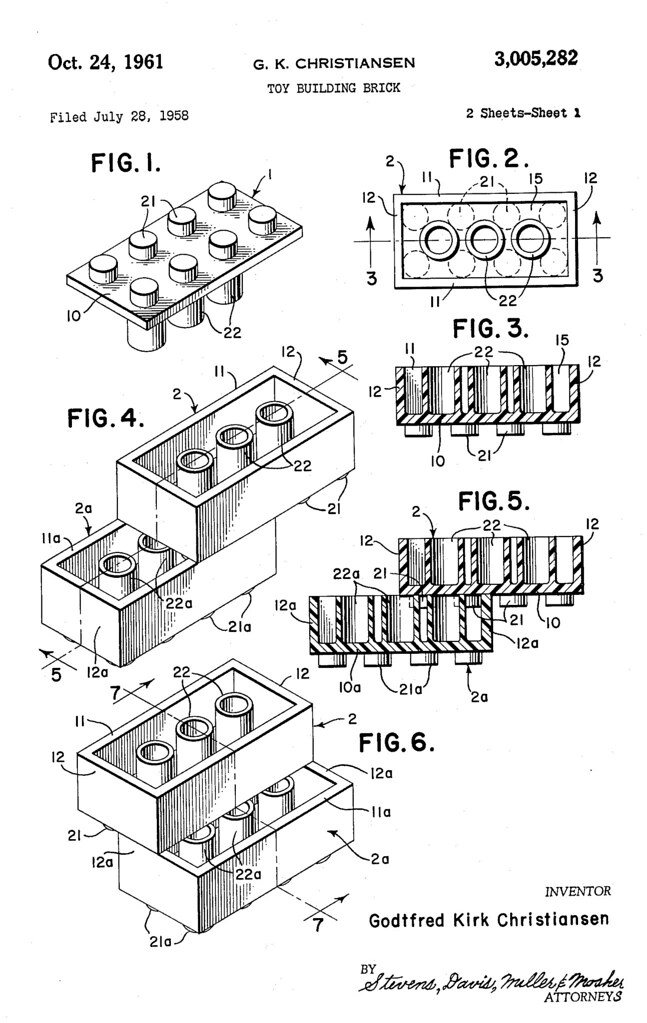Happy Birthday, LEGO Brick!
Posted by Huw,
Today is the day that LEGO celebrates the 60th anniversary of the LEGO brick. It's actually the 60th anniversary the date the patent was filed in Denmark, and the 'priority date' [1] of the US patent.
The patent was granted on January 21 1959 in Denmark, and on October 24, 1961 in the USA.
The full text of the US application can be viewed at Google Patents but we've reproduced the key passages and images after the break.
[1] The priority date is "sometimes called the 'effective filing date', is the date used to establish the novelty and/or obviousness of a particular invention relative to other art." [source].
The patent describes the means by which bricks are connected together, "projections extending from the faces of the elements" engaging with "protruding portions of an adjacent element", which refers, of course, to the studs and tubes on the top and bottom of the bricks, respectively,
Here's the beginning of the patent application text:
"This invention relates to toy building elements and more particularly to toy building bricks or blocks adapted to be connected together by means of projections extending from the faces of the elements and arranged so as to engage protruding portions of an adjacent element when two such elements are assembled.
"Toy elements of this kind will be referred to generally as building bricks, and the principal object of the invention is to provide improved coupling means for clamping such building bricks together in any desired relative position thus providing for a vast variety of combinations of the bricks for making toy structures of many different kinds and shapes.
"Fundamentally, a toy building element according to the invention comprises a base plate provided with projections at either face thereof, the projections at one face being arranged in such a manner relatively to the projections at the other face that the distance between a pair of projections at one face of the base plate is equal to the maximum of the projections at the other face of the base plate."
Bricks with studs on top, 'Self-Locking Building Bricks', had originally been patented by Kiddikraft in the the UK, but crucially, not in Scandinavia, which meant LEGO was free to produce similar ones for that market.
LEGO's first bricks were very similar to Kiddikraft's which lacked tubes on the bottom and instead relied on slotted sides to provide grip. You can read more about Kiddikraft at BrickFetish,

Extract from Kiddikraft's patent.
LEGO's patent therefore goes to some lengths to describe the tubes on the bottom, rather than the studs on top, as it these which were the novelty.
The second page of the diagram offers different configurations and shapes of the connection surfaces underneath. It is interesting to note that the inventor is listed as Godtfred Kirk Christiansen, who had become managing director of LEGO in 1957, rather than Ole Kirk Christiansen who founded the company. In fact, Ole died just six weeks after the priority date of the patent, on the 11th of March 1958 which is before the filing date stated on it.
60 years on and LEGO changed a great deal in some respects, becoming the world's most prominent toy manufacturer and expanding to include many different kinds of pieces within the LEGO System. Nevertheless, the bricks produced today continue to connect with those made in 1958...
Happy Birthday LEGO Brick from all of us here at Brickset! Without you we wouldn't be here!
91 likes

17 comments on this article
Video on the BBC site -
http://www.bbc.co.uk/news/av/stories-42821594/lego-the-invention-of-the-legendary-brick
Happy birthday Lego!
What are the other beneath-bricks configurations on page 2 (fig 9-11)? Had they also been patented with this patent?
^^^ Nice video thank you. I appear not to be able to embed it, unfortunately, otherwise I would.
^ Yes.
Many websites incorrectly state that the standard 2x4 Lego brick has remained unchanged for all this time.
There has in fact been major structural alterations to the design, the most concerning of which being the brick's outside walls being made thinner, likely as some sort of cost cutting exercise.
See here: https://www.cailliau.org/Alphabetical/L/Lego/Dimensions/Shape%20Evolution/Brick2x4.jpeg
^^^ It is a common practice to also patent alternate configurations even if you don't intend to use them. This helps prevent competing companies from making something similar to your invention and getting around your patent because of the differences.
@TheBeefThief - that's not exactly what I would call a "major" structural alteration. It's at best subtle.
Nice drafting!
Thanks for this historical article :) and Happy Birthday to Lego Brick.
Happy Birthday Lego, I hope to continue enjoying your products for years to come.
Happy birthday Lego Brick!!! ZORIONAK!!!
The thinner walls actually appeared for the first time on Duplo's precursor 'Jumbo Bricks', since bigger bricks meant more plastic saved by this alteration :)
What is probably a more important change in design is this addition of the cross-support between tubes and inner walls, that are used to increase the clutch in those areas.
Feliz cumplianos, LEGO!!!
Happy 60th B-day (brick day) LEGO.
This has been driving me mad for years, but can someone explain to me why January 28th is celebrated when the patent clearly says July 28th?
Jan 28th 1958 is the date of the original Danish patent.
This image shows the original one:
http://bit.ly/2niF4XD
Thanks @mdolley! Sorry if it seems like I'm being picky about unimportant things, it just matters to me because my birthday is July 28th and I was trying to figure out if I could say I have the same birthday as the Lego brick.